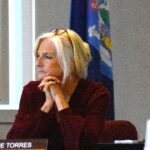
PRESQUE ISLE, Maine — Owners and managers of Aroostook County lumber mills told representatives of the Maine Public Utilities Commission last week that they’re struggling with high electricity prices and uncertainty.
“Our markets are very strong,” David Gordon, CEO of Katahdin Cedar Log Homes, said at a Jan. 31 roundtable discussion. At the same time, Gordon said his sawmills have seen increasing electricity costs.
“It’s a very frustrating thing,” Gordon said, explaining how he had to negotiate down a proposed 89 percent hike in electricity transmission fees from Emera Maine. “You just can’t plan because of the uncertainty.”
Oakfield-based Katahdin Cedar and other Aroostook County’s lumber companies are facing a similar dilemma: rising electricity transmission fees and the possible closure of an important business partner, the ReEnergy biomass plants in Ashland and Fort Fairfield that purchase wood residuals from mills and loggers.
Industrial facilities say electric transmission fees have increased significantly in Aroostook County in the last several years due to a range of factors, including the age of the transmission system and charges for sending power between Northern Maine’s grid, New Brunswick transmission lines and the ISO-New England grid.
Emera Maine is working to rebuild Aroostook County’s 50-year-old transmission system “that has reached the end of its life cycle,” said spokesperson Judy Long.
“We’re at the beginning of a new period of rebuilding the system,” Long said. “It is expected that rates will increase as we replace transmission lines, but the rates will still be very competitive across New England.”
- The ReEnergy biomass plant in Fort Fairfield, seen from Route 1A in October 2017, generates about 260,000 megawatt-hours of electricity each year, enough to power about 34,000 homes. (Anthony Brino)
Meanwhile, ReEnergy, whose Ashland and Fort Fairfield power plants incur $15 million in those transmission fees per year, has notified grid operators that the two plants could be forced to close this September if they don’t see additional revenue, said ReEnergy regional manager Mark Thibodeau. ReEnergy has seen stagnant revenues in recent years due to competition from cheap natural gas in East Coast energy markets and declining reimbursement for renewable energy credits.
The closure of those two plants could wreak havoc on Aroostook County’s $1.5 billion forestry sector, said Bob Dorsey, president of Aroostook Partnership, the Caribou group that organized the meeting. The forestry sector employs about 4,500 people and represents more than 30 percent of The County’s economy, Dorsey said.
“It’s all interdependent and energy is a very critical component,” Dorsey said. “If they were to close, it impacts our entire forest sector value chain: the loggers, the transporters, the mills, the landowners, the landfills.”
If ReEnergy’s plants shut down, “I would be out of business in about 12 months,” said Gordon of Katahdin Cedar. “We would be one of the businesses that would probably go down.”
Gordon said he has tried to develop new markets for the waste products ReEnergy currently purchases — sawdust, wood shavings and bark — to hedge against the possibility of their closure.
Leaders at larger mills are also on edge about ReEnergy’s precarious situation and the price of electricity.
“We supply a lot of the residuals to ReEnergy,” said Doug Cyr, human resources manager with J.D. Irving, Maine’s largest timberlands owner and operator of a large sawmill in Nashville Plantation.
“We have high energy costs but we have to have an outlet for our residuals,” Cyr said.
“At the end of the day, when one of your biggest costs is energy and fiber and you don’t have an outlet or it’s too much, we’ve looked at where do we spend our money?”
Last August, J.D. Irving announced plans to build a $400 million tissue plant in Georgia, Cyr added. “The Irvings aren’t afraid to invest in the right places, but I’m sure they’re looking at energy costs as to where they put things.”
In addition to cost, the quality of electricity can be a major concern, said Charles Tardif, vice president of Maibec, the Quebec company that operates the former Fraser Timber sawmill is Masardis.
“Outages create problems with production, but also when the electricity comes back,” Tardiff said. “A lot of times that really damages the equipment.”
Mark Vannoy, chair of the Maine Public Utilities Commission, told the mill managers that they’re definitely facing a tough problem in securing affordable power from Northern Maine’s grid, which is separate from the ISO-New England grid.
“As I look at it, short of a connection that deals with the New Brunswick wheeling charges for transmission, we don’t have a solution to competitive supply,” Vannoy said.
Barry Hobbins, the Maine PUC’s public advocate, said that addressing the problem of high transmission fees will require the grid operators working together with Emera, ReEnergy and NB Power.
“It’s going to take an effort with ISO-New England,” Hobbins said. “Emera has to help if we’re going to get any relief.”
Aroostook County’s energy problems could also prompt some large electricity users, such as hospitals or manufacturers, to go off the grid and invest in their own heat and power generation, Dorsey said.
That could mean utility charges would go up for everyone else still on the grid. It’s an impact that could be felt when Houlton’s electricity utility, Houlton Water Co., officially leaves the northern Maine grid in 2019 and connects directly with New Brunswick Power in an effort to control costs for Houlton ratepayers.
“What I worry about,” Dorsey said, “is who else might get off the grid like Houlton is doing?”
CORRECTION: A previous version of the story misstated the size of the forestry sector in Aroostook County’s economy. The forestry sector is estimated at $1.5 billion.








